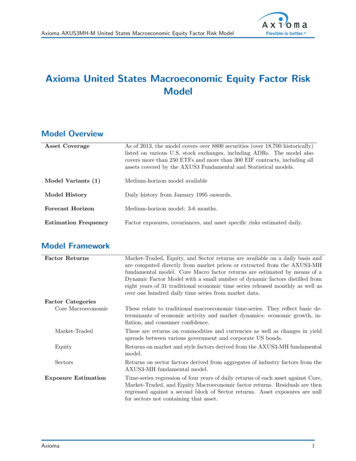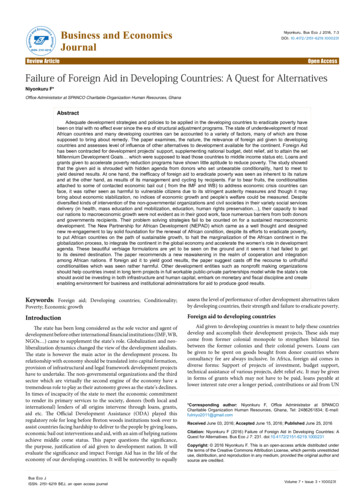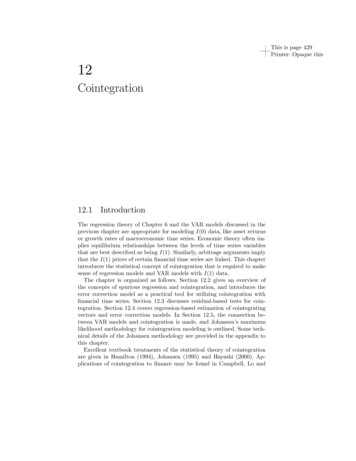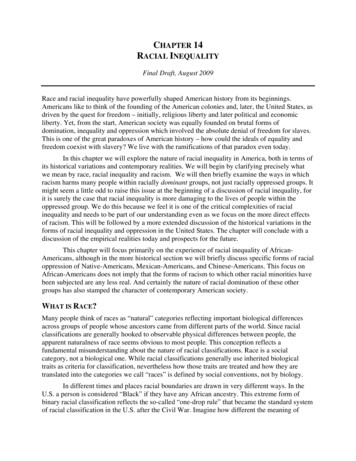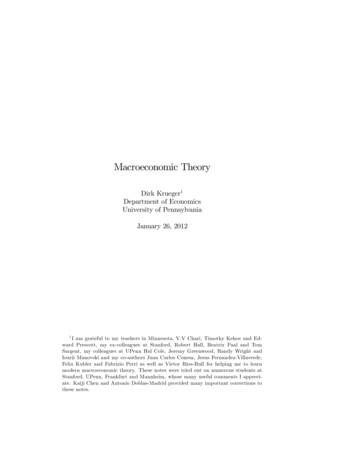
Transcription
Macroeconomic TheoryDirk Krueger1Department of EconomicsUniversity of PennsylvaniaJanuary 26, 20121I am grateful to my teachers in Minnesota, V.V Chari, Timothy Kehoe and Edward Prescott, my ex-colleagues at Stanford, Robert Hall, Beatrix Paal and TomSargent, my colleagues at UPenn Hal Cole, Jeremy Greenwood, Randy Wright andIourii Manovski and my co-authors Juan Carlos Conesa, Jesus Fernandez-Villaverde,Felix Kubler and Fabrizio Perri as well as Victor Rios-Rull for helping me to learnmodern macroeconomic theory. These notes were tried out on numerous students atStanford, UPenn, Frankfurt and Mannheim, whose many useful comments I appreciate. Kaiji Chen and Antonio Doblas-Madrid provided many important corrections tothese notes.
ii
Contents1 Overview and Summary12 A Simple Dynamic Economy2.1 General Principles for Specifying a Model . . . . . . . . .2.2 An Example Economy . . . . . . . . . . . . . . . . . . . .2.2.1 De nition of Competitive Equilibrium . . . . . . .2.2.2 Solving for the Equilibrium . . . . . . . . . . . . .2.2.3 Pareto Optimality and the First Welfare Theorem2.2.4 Negishi’s (1960) Method to Compute Equilibria . .2.2.5 Sequential Markets Equilibrium . . . . . . . . . . .2.3 Appendix: Some Facts about Utility Functions . . . . . .2.3.1 Time Separability . . . . . . . . . . . . . . . . . .2.3.2 Time Discounting . . . . . . . . . . . . . . . . . .2.3.3 Standard Properties of the Period Utility Function2.3.4 Constant Relative Risk Aversion (CRRA) Utility .2.3.5 Homotheticity and Balanced Growth . . . . . . . .556891114182424242525283 The Neoclassical Growth Model in Discrete Time313.1 Setup of the Model . . . . . . . . . . . . . . . . . . . . . . . . . . 313.2 Optimal Growth: Pareto Optimal Allocations . . . . . . . . . . . 323.2.1 Social Planner Problem in Sequential Formulation . . . . 333.2.2 Recursive Formulation of Social Planner Problem . . . . . 353.2.3 An Example . . . . . . . . . . . . . . . . . . . . . . . . . 373.2.4 The Euler Equation Approach and Transversality Conditions . . . . . . . . . . . . . . . . . . . . . . . . . . . . . . 443.2.5 Steady States and the Modi ed Golden Rule . . . . . . . 523.2.6 A Remark About Balanced Growth . . . . . . . . . . . . 533.3 Competitive Equilibrium Growth . . . . . . . . . . . . . . . . . . 553.3.1 De nition of Competitive Equilibrium . . . . . . . . . . . 563.3.2 Characterization of the Competitive Equilibrium and theWelfare Theorems . . . . . . . . . . . . . . . . . . . . . . 583.3.3 Sequential Markets Equilibrium . . . . . . . . . . . . . . . 643.3.4 Recursive Competitive Equilibrium . . . . . . . . . . . . . 653.4 Mapping the Model to Data: Calibration . . . . . . . . . . . . . 67iii
ivCONTENTS4 Mathematical Preliminaries4.1 Complete Metric Spaces . . . . . . .4.2 Convergence of Sequences . . . . . .4.3 The Contraction Mapping Theorem4.4 The Theorem of the Maximum . . .71727377835 Dynamic Programming855.1 The Principle of Optimality . . . . . . . . . . . . . . . . . . . . . 855.2 Dynamic Programming with Bounded Returns . . . . . . . . . . 926 Models with Risk6.1 Basic Representation of Risk . . . . . . . . . .6.2 De nitions of Equilibrium . . . . . . . . . . . .6.2.1 Arrow-Debreu Market Structure . . . .6.2.2 Pareto E ciency . . . . . . . . . . . . .6.2.3 Sequential Markets Market Structure . .6.2.4 Equivalence between Market Structures6.2.5 Asset Pricing . . . . . . . . . . . . . . .6.3 Markov Processes . . . . . . . . . . . . . . . . .6.4 Stochastic Neoclassical Growth Model . . . . .95959798100101102102104106Two Welfare TheoremsWhat is an Economy? . . . . . . . . . . . . . . . . . . . . .Dual Spaces . . . . . . . . . . . . . . . . . . . . . . . . . . .De nition of Competitive Equilibrium . . . . . . . . . . . .The Neoclassical Growth Model in Arrow-Debreu LanguageA Pure Exchange Economy in Arrow-Debreu Language . .The First Welfare Theorem . . . . . . . . . . . . . . . . . .The Second Welfare Theorem . . . . . . . . . . . . . . . . .Type Identical Allocations . . . . . . . . . . . . . . . . . . .1091091121141151171191201288 The Overlapping Generations Model8.1 A Simple Pure Exchange Overlapping Generations Model .8.1.1 Basic Setup of the Model . . . . . . . . . . . . . . .8.1.2 Analysis of the Model Using O er Curves . . . . . .8.1.3 Ine cient Equilibria . . . . . . . . . . . . . . . . . .8.1.4 Positive Valuation of Outside Money . . . . . . . . .8.1.5 Productive Outside Assets . . . . . . . . . . . . . . .8.1.6 Endogenous Cycles . . . . . . . . . . . . . . . . . . .8.1.7 Social Security and Population Growth . . . . . . .8.2 The Ricardian Equivalence Hypothesis . . . . . . . . . . . .8.2.1 In nite Lifetime Horizon and Borrowing Constraints8.2.2 Finite Horizon and Operative Bequest Motives . . .8.3 Overlapping Generations Models with Production . . . . . .8.3.1 Basic Setup of the Model . . . . . . . . . . . . . . .8.3.2 Competitive Equilibrium . . . . . . . . . . . . . . .1291301311361431481501521541601611701751751767 The7.17.27.37.47.57.67.77.8.
CONTENTSv8.3.38.3.4Optimality of Allocations . . . . . . . . . . . . . . . . . . 183The Long-Run E ects of Government Debt . . . . . . . . 1879 Continuous Time Growth Theory9.1 Stylized Growth and Development Facts . . . . . . . . . . . . . .9.1.1 Kaldor’s Growth Facts . . . . . . . . . . . . . . . . . . . .9.1.2 Development Facts from the Summers-Heston Data Set .9.2 The Solow Model and its Empirical Evaluation . . . . . . . . . .9.2.1 The Model and its Implications . . . . . . . . . . . . . . .9.2.2 Empirical Evaluation of the Model . . . . . . . . . . . . .9.3 The Ramsey-Cass-Koopmans Model . . . . . . . . . . . . . . . .9.3.1 Mathematical Preliminaries: Pontryagin’s Maximum Principle . . . . . . . . . . . . . . . . . . . . . . . . . . . . . .9.3.2 Setup of the Model . . . . . . . . . . . . . . . . . . . . . .9.3.3 Social Planners Problem . . . . . . . . . . . . . . . . . . .9.3.4 Decentralization . . . . . . . . . . . . . . . . . . . . . . .9.4 Endogenous Growth Models . . . . . . . . . . . . . . . . . . . . .9.4.1 The Basic AK-Model . . . . . . . . . . . . . . . . . . . .9.4.2 Models with Externalities . . . . . . . . . . . . . . . . . .9.4.3 Models of Technological Progress Based on MonopolisticCompetition: Variant of Romer (1990) . . . . . . . . . . .19319319419419920220421510 Bewley Models10.1 Some Stylized Facts about the Income and Wealthin the U.S. . . . . . . . . . . . . . . . . . . . . . . .10.1.1 Data Sources . . . . . . . . . . . . . . . . .10.1.2 Main Stylized Facts . . . . . . . . . . . . .10.2 The Classic Income Fluctuation Problem . . . . .10.2.1 Deterministic Income . . . . . . . . . . . .10.2.2 Stochastic Income and Borrowing Limits . .10.3 Aggregation: Distributions as State Variables . . .10.3.1 Theory . . . . . . . . . . . . . . . . . . . .10.3.2 Numerical Results . . . . . . . . . . . . . .261Distribution. . . . . . . . . . . . . . . . . . . . . . . . . . . . . . . . . . . . . . . . . . . . . . . . . . . . . . . . . . . . . . . 8911 Fiscal Policy11.1 Positive Fiscal Policy . . . . . . . . . . . . . . . . . . . . . . . . .11.2 Normative Fiscal Policy . . . . . . . . . . . . . . . . . . . . . . .11.2.1 Optimal Policy with Commitment . . . . . . . . . . . . .11.2.2 The Time Consistency Problem and Optimal Fiscal Policywithout Commitment . . . . . . . . . . . . . . . . . . . .29329329329312 Political Economy and Macroeconomics29513 References297293
viCONTENTS
Chapter 1Overview and SummaryAfter a quick warm-up for dynamic general equilibrium models in the rst partof the course we will discuss the two workhorses of modern macroeconomics, theneoclassical growth model with in nitely lived consumers and the OverlappingGenerations (OLG) model. This rst part will focus on techniques rather thanissues; one rst has to learn a language before composing poems.I will rst present a simple dynamic pure exchange economy with two in nitely lived consumers engaging in intertemporal trade. In this model theconnection between competitive equilibria and Pareto optimal equilibria can beeasily demonstrated. Furthermore it will be demonstrated how this connection can exploited to compute equilibria by solving a particular social plannersproblem, an approach developed rst by Negishi (1960) and discussed nicely byKehoe (1989).This model with then enriched by production (and simpli ed by droppingone of the two agents), to give rise to the neoclassical growth model. Thismodel will rst be presented in discrete time to discuss discrete-time dynamicprogramming techniques; both theoretical as well as computational in nature.The main reference will be Stokey et al., chapters 2-4. As a rst economicapplication the model will be enriched by technology shocks to develop theReal Business Cycle (RBC) theory of business cycles. Cooley and Prescott(1995) are a good reference for this application. In order to formulate thestochastic neoclassical growth model notation for dealing with uncertainty willbe developed.This discussion will motivate the two welfare theorems, which will then bepresented for quite general economies in which the commodity space may bein nite-dimensional. We will draw on Stokey et al., chapter 15’s discussion ofDebreu (1954).The next two topics are logical extensions of the preceding material. We will rst discuss the OLG model, due to Samuelson (1958) and Diamond (1965).The rst main focus in this module will be the theoretical results that distinguishthe OLG model from the standard Arrow-Debreu model of general equilibrium:in the OLG model equilibria may not be Pareto optimal, at money may have1
2CHAPTER 1. OVERVIEW AND SUMMARYpositive value, for a given economy there may be a continuum of equilibria(and the core of the economy may be empty). All this could not happen inthe standard Arrow-Debreu model. References that explain these di erences indetail include Geanakoplos (1989) and Kehoe (1989). Our discussion of theseissues will largely consist of examples. One reason to develop the OLG modelwas the uncomfortable assumption of in nitely lived agents in the standardneoclassical growth model. Barro (1974) demonstrated under which conditions(operative bequest motives) an OLG economy will be equivalent to an economywith in nitely lived consumers. One main contribution of Barro was to providea formal justi cation for the assumption of in nite lives. As we will see thismethodological contribution has profound consequences for the macroeconomice ects of government debt, reviving the Ricardian Equivalence proposition. Asa prelude we will brie‡y discuss Diamond’s (1965) analysis of government debtin an OLG model.In the next module we will discuss the neoclassical growth model in continuous time to develop continuous time optimization techniques. After havinglearned the technique we will review the main developments in growth theory and see how the various growth models fare when being contrasted withthe main empirical ndings from the Summers-Heston panel data set. We willbrie‡y discuss the Solow model and its empirical implications (using the article by Mankiw et al. (1992) and Romer, chapter 2), then continue with theRamsey model (Intriligator, chapter 14 and 16, Blanchard and Fischer, chapter2). In this model growth comes about by introducing exogenous technologicalprogress. We will then review the main contributions of endogenous growth theory, rst by discussing the early models based on externalities (Romer (1986),Lucas (1988)), then models that explicitly try to model technological progress(Romer (1990).All the models discussed up to this point usually assumed that individualsare identical within each generation (or that markets are complete), so thatwithout loss of generality we could assume a single representative consumer(within each generation). This obviously makes life easy, but abstracts from alot of interesting questions involving distributional aspects of government policy.In the next section we will discuss a model that is capable of addressing theseissues. There is a continuum of individuals. Individuals are ex-ante identical(have the same stochastic income process), but receive di erent income realizations ex post. These income shocks are assumed to be uninsurable (we thereforedepart from the Arrow-Debreu world), but people are allowed to self-insure byborrowing and lending at a risk-free rate, subject to a borrowing limit. Deaton(1991) discusses the optimal consumption-saving decision of a single individualin this environment and Aiyagari (1994) incorporates Deaton’s analysis into afull-blown dynamic general equilibrium model. The state variable for this economy turns out to be a cross-sectional distribution of wealth across individuals.This feature makes the model interesting as distributional aspects of all kindsof government policies can be analyzed, but it also makes the state space verybig. A cross-sectional distribution as state variable requires new concepts (developed in measure theory) for de ning and new computational techniques for
3computing equilibria. The early papers therefore restricted attention to steadystate equilibria (in which the cross-sectional wealth distribution remained constant). Very recently techniques have been developed to handle economies withdistributions as state variables that feature aggregate shocks, so that the crosssectional wealth distribution itself varies over time. Krusell and Smith (1998)is the key reference. Applications of their techniques to interesting policy questions could be very rewarding in the future. If time permits I will discuss suchan application due to Heathcote (1999).For the next two topics we will likely not have time; and thus the corresponding lecture notes are work in progress. So far we have not consideredhow government policies a ect equilibrium allocations and prices. In the nextmodules this question is taken up. First we discuss scal policy and we startwith positive questions: how does the governments’decision to nance a givenstream of expenditures (debt vs. taxes) a ect macroeconomic aggregates (Barro(1974), Ohanian (1997))?; how does government spending a ect output (Baxterand King (1993))? In this discussion government policy is taken as exogenouslygiven. The next question is of normative nature: how should a benevolent government carry out scal policy? The answer to this question depends cruciallyon the assumption of whether the government can commit to its policy. A government that can commit to its future policies solves a classical Ramsey problem(not to be confused with the Ramsey model); the main results on optimal scalpolicy are reviewed in Chari and Kehoe (1999). Kydland and Prescott (1977)pointed out the dilemma a government faces if it cannot commit to its policy-this is the famous time consistency problem. How a benevolent governmentthat cannot commit should carry out scal policy is still very much an openquestion. Klein and Rios-Rull (1999) have made substantial progress in answering this question. Note that we throughout our discussion assume that thegovernment acts in the best interest of its citizens. What happens if policies areinstead chosen by votes of sel sh individuals is discussed in the last part of thecourse.As discussed before we assumed so far that government policies were either xed exogenously or set by a benevolent government (that can or can’t commit).Now we relax this assumption and discuss political-economic equilibria in whichpeople not only act rationally with respect to their economic decisions, but alsorationally with respect to their voting decisions that determine macroeconomicpolicy. Obviously we rst had to discuss models with heterogeneous agents sincewith homogeneous agents there is no political con‡ict and hence no interestingdi erences between the Ramsey problem and a political-economic equilibrium.This area of research is not very far developed and we will only present twoexamples (Krusell et al. (1997), Alesina and Rodrik (1994)) that deal with thequestion of capital taxation in a dynamic general equilibrium model in whichthe capital tax rate is decided upon by repeated voting.
4CHAPTER 1. OVERVIEW AND SUMMARY
Chapter 2A Simple DynamicEconomy2.1General Principles for Specifying a ModelAn economic model consists of di erent types of entities that take decisionssubject to constraints. When writing down a model it is therefore crucial toclearly state what the agents of the model are, which decisions they take, whatconstraints they have and what information they possess when making theirdecisions. Typically a model has (at most) three types of decision-makers1. Households: We have to specify households’preferences over commodities and their endowments of these commodities. Households are assumed to optimize their preferences over a constraint set that speci eswhich combination of commodities a household can choose from. This setusually depends on initial household endowments and on market prices.2. Firms: We have to specify the production technology available to rms,describing how commodities (inputs) can be transformed into other commodities (outputs). Firms are assumed to maximize (expected) pro ts,subject to their production plans being technologically feasible.3. Government: We have to specify what policy instruments (taxes, moneysupply etc.) the government controls. When discussing government policyfrom a positive point of view we will take government polices as given(of course requiring the government budget constraint(s) to be satis ed),when discussing government policy from a normative point of view wewill endow the government, as households and rms, with an objectivefunction. The government will then maximize this objective function bychoosing policy, subject to the policies satisfying the government budgetconstraint(s)).5
6CHAPTER 2. A SIMPLE DYNAMIC ECONOMYIn addition to specifying preferences, endowments, technology and policy,we have to specify what information agents possess when making decisions.This will become clearer once we discuss models with risk. Finally we haveto be precise about how agents interact with each other. Most of economicsfocuses on market interaction between agents; this will be also the case in thiscourse. Therefore we have to specify our equilibrium concept, by makingassumptions about how agents perceive their power to a ect market prices.In this course we will focus on competitive equilibria, by assuming that allagents in the model (apart from possibly the government) take market pricesas given and beyond their control when making their decisions. An alternativeassumption would be to allow for market power of rms or households, whichinduces strategic interactions between agents in the model. Equilibria involvingstrategic interaction have to be analyzed using methods from modern gametheory.To summarize, a description of any model in this course should always contain the speci cation of the elements in bold letters: what commodities aretraded, preferences over and endowments of these commodities, technology, government policies, the information structure and the equilibrium concept.2.2An Example EconomyTime is discrete and indexed by t 0; 1; 2; : : : There are 2 individuals that liveforever in this pure exchange economy.1 There are no rms, and the government is absent as well. In each period the two agents consume a nonstorableconsumption good. Hence there are (countably) in nite number of commodities,namely consumption in periods t 0; 1; 2; : : :De nition 1 An allocation is a sequence (c1 ; c2 ) f(c1t ; c2t )g1t 0 of consumption in each period for each individual.Individuals have preferences over consumption allocations that can be represented by the utility functionu(ci ) 1Xtln(cit )(2.1)t 0with 2 (0; 1):This utility function satis es some assumptions that we will often require inthis course. These are further discussed in the appendix to this chapter. Notethat both agents are assumed to have the same time discount factor :1 One may wonder how credible the assumption is that households take prices as given inan economy with two households. To address this concern, let there be instead two classesof households with equal size. Within each class, there are many households (if you want tobe really safe, a continuum) that are all identical and described as in the main text. Thiseconomy has the same equilibria as the one described in the main text.
2.2. AN EXAMPLE ECONOMY7Agents have deterministic endowment streams ei feit g1t 0 of the consumption goods given bye1t 2 if t is even0 if t is odde2t 0 if t is even2 if t is oddThere is no risk in this model and both agents know their endowment patternperfectly in advance. All information is public, i.e. all agents know everything.At period 0; before endowments are received and consumption takes place, thetwo agents meet at a central market place and trade all commodities, i.e. tradeconsumption for all future dates. Let pt denote the price, in period 0; of oneunit of consumption to be delivered in period t; in terms of an abstract unitof account. We will see later that prices are only determined up to a constant,so we can always normalize the price of one commodity to 1 and make it thenumeraire. Both agents are assumed to behave competitively in that they takethe sequence of prices fpt g1t 0 as given and beyond their control when makingtheir consumption decisions.After trade has occurred agents possess pieces of paper (one may call themcontracts) statingin period 212 I, agent 1; will deliver 0.25 units of the consumptiongood to agent 2 (and will eat the remaining 1.75 units)in period 2525 I, agent 1; will receive one unit of the consumptiongood from agent 2 (and eat it).and so forth. In all future periods the only thing that happens is that agentsmeet (at the market place again) and deliveries of the consumption goods theyagreed upon in period 0 takes place. Again, all trade takes place in period 0and agents are committed in future periods to what they have agreed upon inperiod 0: There is perfect enforcement of these contracts signed in period 0:22 A market structure in which agents trade only at period 0 will be called an Arrow-Debreumarket structure. We will show below that this market structure is equivalent to a marketstructure in which trade in consumption and a particular asset takes place in each period, amarket structure that we will call sequential markets.
8CHAPTER 2. A SIMPLE DYNAMIC ECONOMY2.2.1De nition of Competitive EquilibriumGiven a sequence of prices fpt g1t 0 households solve the following optimizationproblemmaxi 1fct gt 01Xs.t.1Xpt citt 01Xtln(cit )t 0pt eitt 0cit0 for all tNote that the budget constraint can be rewritten as1Xpt (eitcit )0t 0The quantity eit cit is the net trade of consumption of agent i for period t whichmay be positive or negative.For arbitrary prices fpt g1t 0 it may be the case that total consumption inthe economy desired by both agents, c1t c2t at these prices does not equal total2: We will call equilibrium a situation in which pricesendowments e1t e2tare “right” in the sense that they induce agents to choose consumption so thattotal consumption equals total endowment in each period. More precisely, wehave the following de nitionDe nition 2 A (competitive) Arrow-Debreu equilibrium are prices f p t g1t 0 andi 1allocations (f ct gt 0 )i 1;2 such that1. Given f p t g1cit g1t 0 solvest 0 ; for i 1; 2; f maxi 1fct gt 01Xp t citt 0s.t.1X1Xtln(cit )(2.2)t 0p t eit(2.3)0 for all t(2.4)t 0cit2.c 1t c 2t e1t e2t for all t(2.5)The elements of an equilibrium are allocations and prices. Note that wedo not allow free disposal of goods, as the market clearing condition is stated
2.2. AN EXAMPLE ECONOMY9as an equality.3 Also note the ’s in the appropriate places: the consumptionallocation has to satisfy the budget constraint (2:3) only at equilibrium pricesand it is the equilibrium consumption allocation that satis es the goods marketclearing condition (2:5): Since in this course we will usually talk about competitive equilibria, we will henceforth take the adjective “competitive”as beingunderstood.2.2.2Solving for the EquilibriumFor arbitrary prices fpt g1t 0 let’s rst solve the consumer problem. Attachthe Lagrange multiplier i to the budget constraint. The rst order necessaryconditions for cit and cit 1 are thentcitt 1cit 1 i pt(2.6) i pt 1(2.7)and hencept 1 cit 1 pt cit for all t(2.8)for i 1; 2:Equations (2:8); together with the budget constraint can be solved for theoptimal sequence of consumption of household i as a function of the in nitesequence of prices (and of the endowments, of course)cit cit (fpt g1t 0 )In order to solve for the equilibrium prices fpt g1t 0 one then uses the goodsmarket clearing conditions (2:5)2112c1t (fpt g1t 0 ) ct (fpt gt 0 ) et et for all tThis is a system of in nite equations (for each t one) in an in nite numberof unknowns fpt g1t 0 which is in general hard to solve. Below we will discussNegishi’s method that often proves helpful in solving for equilibria by reducingthe number of equations and unknowns to a smaller number.For our particular simple example economy, however, we can solve for theequilibrium directly. Sum (2:8) across agents to obtainpt 1 c1t 1 c2t 1 pt (c1t c2t )3 Di erent people have di erent tastes as to whether one should allow free disposal or not.Personally I think that if one wishes to allow free disposal, one should specify this as part oftechnology (i.e. introduce a rm that has available a technology that uses positive inputs toproduce zero output; obviously for such a rm to be operative in equilibrium it has to be thecase that the price of the inputs are non-positive -think about goods that are actually badssuch as pollution).
10CHAPTER 2. A SIMPLE DYNAMIC ECONOMYUsing the goods market clearing condition we nd thatpt 1 e1t 1 e2t 1 pt (e1t e2t )and hencept 1 ptand therefore equilibrium prices are of the formtpt p0Without loss of generality we can set p0 1; i.e. make consumption at period0 the numeraire.4 Then equilibrium prices have to satisfyp t tso that, since 1, the period 0 price for period t consumption is lower than theperiod 0 price for period 0 consumption. This fact just re‡ects the impatienceof both agents.Using (2:8) we have that cit 1 cit ci0 for all t, i.e. consumption isconstant across time for both agents. This re‡ects the agent’s desire to smoothconsumption over time, a consequence of the strict concavity of the period utilityfunction. Now observe that the budget constraint of both agents will hold withequality since agents’period utility function is strictly increasing. The left handside of the budget constraint becomes1Xp t cit ci0t 01Xt t 0ci01for i 1; 2:The two agents di er only along one dimension: agent 1 is rich rst, which,given that prices are declining over time, is an advantage. For agent 1 the righthand side of the budget constraint becomes1Xp t e1t 2t 01X2t t 0221and for agent 2 it becomes1Xp t e2t 2t 01X2t t 0212The equilibrium allocation is then given byc 1t c 10 (1)c 2t c 20 (1)22121221 2 1 1 14 Note that multiplying all prices by 0 does not change the budget constraints of agents,i 1so that if prices fpt g1t 0 and allocations (fct gt 0 )i21;2 are an AD equilibrium, so are pricesi g1 )f pt g 1andallocations(fct t 0 i 1;2t 0
2.2. AN EXAMPLE ECONOMY11which obviously satis esc 1t c 2t 2 e 1t e 2t for all tTherefore the mere fact that the rst agent is rich rst makes her consumemore in every period. Note that there is substantial trade going on; in each2to the second agent and ineven period the rst agent delivers 2 1 2 1 2all odd periods the second agent delivers 2 1 to the rst agent. Also notethat this trade is mutually bene cial, because without trade both agents receivelifetime utilityu(eit ) 1whereas with trade they obtainu( c1 ) 1Xtln21 ln21 t 02u( c ) 1Xt 0tln 1ln 21 21 1 0 0In the next section we will show that not only are both agents better o inthe competitive equilibrium than by just eating their endowment, but that, ina sense to be made precise, the equilibrium consumption allocation is sociallyoptimal.2.2.3Pareto Optimality and the First Welfare TheoremIn this section we will demonstrate that for this economy a competitive equilibrium is socially optimal. To do this we rst have to de ne what sociallyoptimal means. Our notion of optimality will be Pareto e ciency (also sometimes referred to as Pareto optimality). Loosely speaking, an allocation is Paretoe cient if it is feasible and if there is no other feasible allocation that makes nohousehold worse o and at least one household strictly better o . Let us nowmake this precise.De nition 3 An allocation f(c1t ; c2t )g1t 0 is feasible if1.cit0 for all t; for i 1; 22.c1t c2t e1t e2t for all tFeasibility requires that consumption is nonnegative and satis es the resource constraint for all periods t 0; 1; : : :
12CHAPTER 2. A SIMPLE DYNAMIC ECONOMYDe nition 4 An allocation f(c1t ; c2t )g1t 0 is Pareto e cient if it is feasible andif there is no other feasible allocation f( c1t ; c 2t )g1t 0 such thatu( ci )u(ci ) for both i 1; 2u( ci ) u(ci ) for at least one i 1; 2Note that Pareto e ciency has nothing to do with fairness in any sense: anallocation in which agent 1 consumes everything in every period and agent 2starves is Pareto e cient, since we can only make agent 2 better o by makingagent 1 worse o .We now prove that every competitive equilibrium allocation for the economydescribed above is Par
Macroeconomic Theory Dirk Krueger1 Department of Economics University of Pennsylvania January 26, 2012 1I am grateful to my teachers in Minnesota, V.V Chari, Timothy Kehoe and Ed- ward Prescott, my ex-
